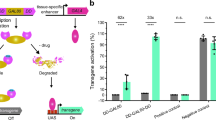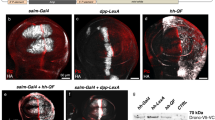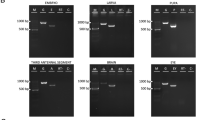Abstract
MARCM (mosaic analysis with a repressible cell marker) involves specific labeling of GAL80-minus and GAL4-positive homozygous cells in otherwise heterozygous tissues. Here we demonstrate how the concurrent use of two independent binary transcriptional systems may facilitate complex MARCM studies in the Drosophila nervous system. By fusing LexA with the VP16 acidic activation domain (VP16) or the GAL4 activation domain (GAD), we obtained both GAL80-insensitive and GAL80-suppressible transcriptional factors. LexA::VP16 can mediate MARCM-independent binary transgene induction in mosaic organisms. The incorporation of LexA::GAD into MARCM, which we call dual-expression-control MARCM, permits the induction of distinct transgenes in different patterns among GAL80-minus cells in mosaic tissues. Lineage analysis with dual-expression-control MARCM suggested the presence of neuroglioblasts in the developing optic lobes but did not indicate the production of glia by postembryonic mushroom body neuronal precursors. In addition, dual-expression-control MARCM with a ubiquitous LexA::GAD driver revealed many unidentified cells in the GAL4-GH146-positive projection neuron lineages.
This is a preview of subscription content, access via your institution
Access options
Subscribe to this journal
Receive 12 print issues and online access
$209.00 per year
only $17.42 per issue
Buy this article
- Purchase on SpringerLink
- Instant access to full article PDF
Prices may be subject to local taxes which are calculated during checkout





Similar content being viewed by others
References
Xu, T. & Rubin, G.M. Analysis of genetic mosaics in developing and adult Drosophila tissues. Development 117, 1223–1237 (1993).
Lee, T. & Luo, L. Mosaic analysis with a repressible cell marker for studies of gene function in neuronal morphogenesis. Neuron 22, 451–461 (1999).
Zugates, C.T. & Lee, T. Genetic mosaic analysis in the nervous system. Curr. Opin. Neurobiol. 14, 647–653 (2004).
Zong, H. et al. Mosaic analysis with double markers in mice. Cell 121, 479–492 (2005).
Lee, T. & Luo, L. Mosaic analysis with a repressible cell marker (MARCM) for Drosophila neural development. Trends Neurosci. 24, 251–254 (2001).
Lee, T., Lee, A. & Luo, L. Development of the Drosophila mushroom bodies: sequential generation of three distinct types of neurons from a neuroblast. Development 126, 4065–4076 (1999).
Jefferis, G.S., Marin, E.C., Stocker, R.F. & Luo, L. Target neuron prespecification in the olfactory map of Drosophila. Nature 414, 204–208 (2001).
Lee, T. et al. Essential roles of Drosophila RhoA in the regulation of neuroblast proliferation and dendritic but not axonal morphogenesis. Neuron 25, 307–316 (2000).
Wang, J. et al. Transmembrane/juxtamembrane domain-dependent Dscam distribution and function during mushroom body neuronal morphogenesis. Neuron 43, 663–672 (2004).
Lee, T. et al. Cell-autonomous requirement of the USP/EcR-B ecdysone receptor for mushroom body neuronal remodeling in Drosophila. Neuron 28, 807–818 (2000).
Wang, J. et al. Drosophila Dscam is required for divergent segregation of sister branches and suppresses ectopic bifurcation of axons. Neuron 33, 559–571 (2002).
Zheng, X. et al. TGF-β signaling activates steroid hormone receptor expression during neuronal remodeling in the Drosophila brain. Cell 112, 303–315 (2003).
Brand, A.H. & Perrimon, N. Targeted gene expression as a means of altering cell fates and generating dominant phenotypes. Development 118, 401–415 (1993).
Yang, M.Y. et al. Subdivision of the Drosophila mushroom bodies by enhancer-trap expression patterns. Neuron 15, 45–54 (1995).
Manseau, L. et al. GAL4 enhancer traps expressed in the embryo, larval brain, imaginal discs, and ovary of Drosophila. Dev. Dyn. 209, 310–322 (1997).
Kidd, S., Lieber, T. & Young, M.W. Ligand-induced cleavage and regulation of nuclear entry of Notch in Drosophila melanogaster embryos. Genes Dev. 12, 3728–3740 (1998).
Szuts, D. & Bienz, M. LexA chimeras reveal the function of Drosophila Fos as a context-dependent transcriptional activator. Proc. Natl. Acad. Sci. USA 97, 5351–5356 (2000).
Estojak, J., Brent, R. & Golemis, E.A. Correlation of two-hybrid affinity data with in vitro measurements. Mol. Cell. Biol. 15, 5820–5829 (1995).
Brent, R. & Ptashne, M. A eukaryotic transcriptional activator bearing the DNA specificity of a prokaryotic repressor. Cell 43, 729–736 (1985).
Triezenberg, S.J., Kingsbury, R.C. & McKnight, S.L. Functional dissection of VP16, the trans-activator of herpes simplex virus immediate early gene expression. Genes Dev. 2, 718–729 (1988).
Ma, J. & Ptashne, M. The carboxy-terminal 30 amino acids of GAL4 are recognized by GAL80. Cell 50, 137–142 (1987).
Stocker, R.F., Lienhard, M.C., Borst, A. & Fischbach, K.F. Neuronal architecture of the antennal lobe in Drosophila melanogaster. Cell Tissue Res. 262, 9–34 (1990).
Ptashne, M. How eukaryotic transcriptional activators work. Nature 335, 683–689 (1988).
Wang, J.W. et al. Two-photon calcium imaging reveals an odor-evoked map of activity in the fly brain. Cell 112, 271–282 (2003).
Xiong, W.C. & Montell, C. Defective glia induce neuronal apoptosis in the Repo visual system of Drosophila. Neuron 14, 581–590 (1995).
Laissue, P.P. et al. Three-dimensional reconstruction of the antennal lobe in Drosophila melanogaster. J. Comp. Neurol. 405, 543–552 (1999).
Stocker, R.F., Heimbeck, G., Gendre, N. & deBelle, J.S. Neuroblast ablation in Drosophila P[GAL4] lines reveals origins of olfactory interneurons. J. Neurobiol. 32, 443–456 (1997).
Connolly, J.B. et al. Associative learning disrupted by impaired Gs signaling in Drosophila mushroom bodies. Science 274, 2104–2107 (1996).
Robinow, S. & White, K. Characterization and spatial distribution of the ELAV protein during Drosophila melanogaster development. J. Neurobiol. 22, 443–461 (1991).
Ito, K. et al. The Drosophila mushroom body is a quadruple structure of clonal units each of which contains a virtually identical set of neurons and glial cells. Development 124, 761–771 (1997).
Zhu, S., Chiang, A.S. & Lee, T. Development of the Drosophila mushroom bodies: elaboration, remodeling and spatial organization of dendrites in the calyx. Development 130, 2603–2610 (2003).
Truman, J. & Bate, M. Spatial and temporal patterns of neurogenesis in the central nervous system of Drosophila melanogaster. Dev. Biol. 125, 145–157 (1988).
Ito, K. & Hotta, Y. Proliferation pattern of postembryonic neuroblasts in the brain of Drosophila melanogaster. Dev. Biol. 149, 134–148 (1992).
Dearborn, R., Jr. & Kunes, S. An axon scaffold induced by retinal axons directs glia to destinations in the Drosophila optic lobe. Development 131, 2291–2303 (2004).
Wilson, R.I. & Laurent, G. Role of GABAergic inhibition in shaping ordor-evoked spatiotemporal patterns in the Drosophila antennal lobe. J. Neurosci. 25, 9069–9079 (2005).
Duffy, J.B. GAL4 system in Drosophila: a fly geneticist's swiss army knife. Genesis 34, 1–15 (2002).
Vojtek, A.B., Hollenberg, S.M. & Cooper, A.J. Mammalian Ras interacts directly with the serine/threonine kinase Raf. Cell 74, 205–214 (1993).
Wong, A.M., Wang, J.W. & Axel, R. Spatial representation of the glomerular map in the Drosophila protocerebrum. Cell 109, 229–241 (2002).
Spradling, A.C. & Rubin, G.M. Transposition of cloned P elements into Drosophila germ line chromosomes. Science 218, 341–347 (1982).
Acknowledgements
We thank J. Ma for pBTM116, S. Hanes for pSH18-34 and G. Struhl for GF51; L. Luo and L. Vosshall for sending us GAL4-GH146 and Or83b-GAL4 flies, respectively; C.T. Zugates and B. Leung for critical reading of the manuscript. This work was supported by the US National Institutes of Health and March of Dimes Birth Defects Foundation. T.L. is a Klingenstein Fellow.
Author information
Authors and Affiliations
Corresponding author
Ethics declarations
Competing interests
The authors declare no competing financial interests.
Supplementary information
Supplementary Fig. 1
Comparison of LexA::GAD/lexAop with GAL4/UAS (PDF 63 kb)
Rights and permissions
About this article
Cite this article
Lai, SL., Lee, T. Genetic mosaic with dual binary transcriptional systems in Drosophila. Nat Neurosci 9, 703–709 (2006). https://doi.org/10.1038/nn1681
Received:
Accepted:
Published:
Issue Date:
DOI: https://doi.org/10.1038/nn1681



